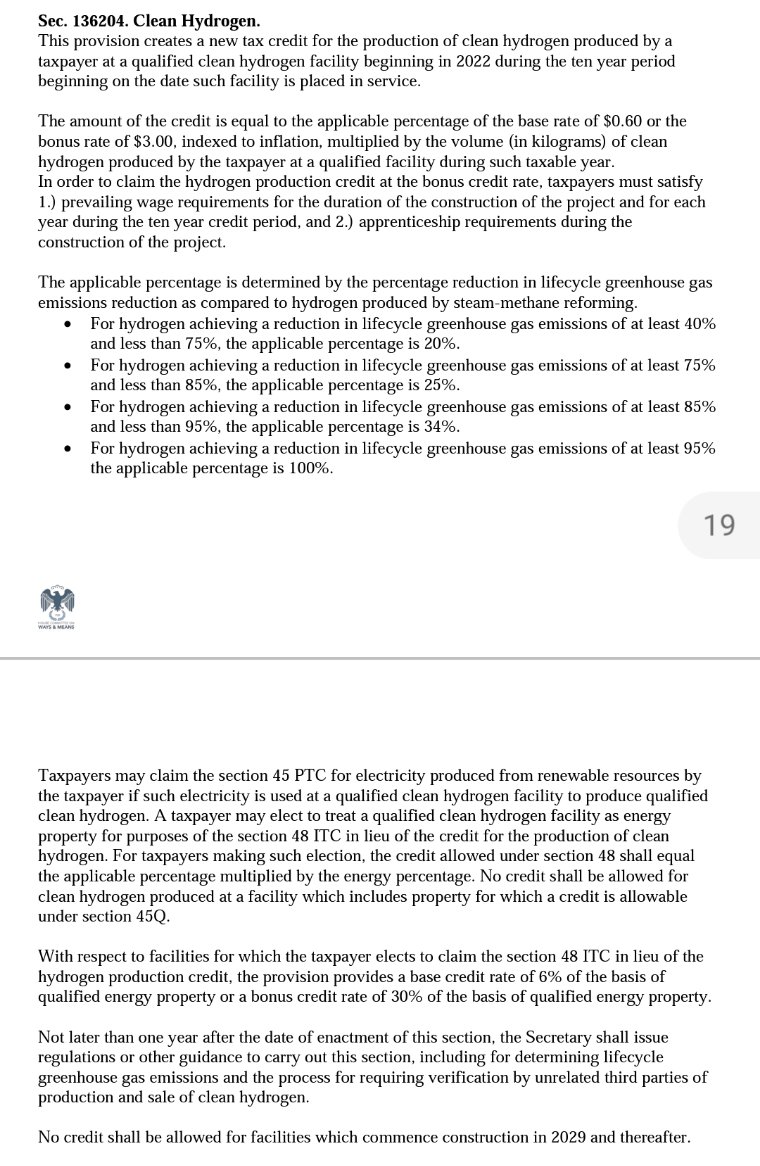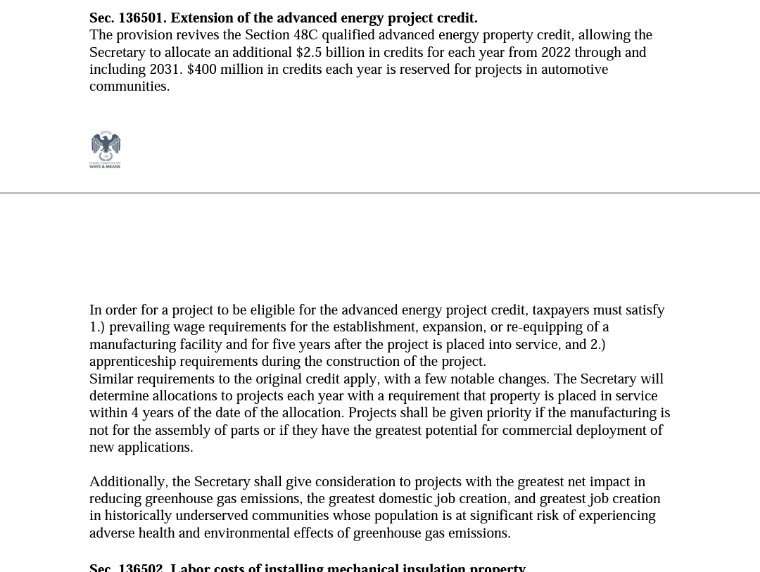
Good morning. This bill is pretty epic!
Here is a section by section summary of what's in draft tax package from the House Ways & Means Cmte: waysandmeans.house.gov/sites/democrat…
(Part of it anyway, related to Infrastructure Financing, Green Energy, Social Safety Net, and Prescription Drugs)
Here is a section by section summary of what's in draft tax package from the House Ways & Means Cmte: waysandmeans.house.gov/sites/democrat…
(Part of it anyway, related to Infrastructure Financing, Green Energy, Social Safety Net, and Prescription Drugs)
https://twitter.com/JesseJenkins/status/1436520880226586628
First off, the clean electricity tax credits are now structured with strong incentives to pay good wages, train apprentice skilled workers, and use domestic produced iron, steel & manufactured content.
To get full tax credit values (referred to as "bonus rate"), projects must pay prevailing wages & use certain percentage of labor hours from qualified apprentice workers. Otherwise, tax credit value is only 1/5th of full value (referred to as "base" rate).
Additionally, for projects that use domestic content (at least 55% of total cost of project is made in USA), they can generally get a 10% increase in the value of the applicable tax credit. (e.g. a $25/MWh PTC becomes $27.5/MWh, 30% ITC becomes 33%).
First big tax incentive: production tax credit for wind, solar, geothermal, landfill gas etc.
$25/MWh full rate ($5/MWh base rate) for projects commencing construction before end of 2031. Phases out over 2032-2033.
Solar can elect this PTC (which I think will be common) or ITC.

$25/MWh full rate ($5/MWh base rate) for projects commencing construction before end of 2031. Phases out over 2032-2033.
Solar can elect this PTC (which I think will be common) or ITC.


Oops, here's the description of prevailing wage and apprenticeship requirements I meant to include above. 

Next up: Investment Tax Credit for solar, geothermal, and newly qualifying: energy storage, biogas, microgrid controllers and a couple more.
30% full value (6% base) for projects begin construction before end of 2031. Phase out over 2032-2033.
33% if you use domestic content.
30% full value (6% base) for projects begin construction before end of 2031. Phase out over 2032-2033.
33% if you use domestic content.

Note that both of these important incentives (PTC and ITC) are returned to their original full value, and are higher than the current incentives available to most technologies (eg 26% for solar, $15/MWh for wind projects that start construction before end of this year)
There's a new bonus ITC for solar projects deployed in low income and environmental justice communities as well. 10-20% bonus. Im not certain if that's percentage points (making full potential ITC 43-53% if using domestic content!) or 10-20% of 30% ITC (36-39% w/domestic content) 

Ok this is critical: the ITC be PTC, 45Q for CCS etc are now eligible for "direct pay" or fully refundable, rather than only available as offset against taxes owed. This is a game changer. Means no more wasteful tax equity financing! 

Projects meeting domestic content requirement get full direct pay. That's added incentive to use Made in USA materials & manufactured content.
Those that don't use domestic content get 100% value for projects starting before end of 2023, 90% for 2024, 85% for 2025, 0% thereafter
Those that don't use domestic content get 100% value for projects starting before end of 2023, 90% for 2024, 85% for 2025, 0% thereafter
Without direct pay/refundability, clean electricity projects have had to use complex tax equity deals where big banks or others with tax liability take equity investment in project in exchange for tax credits.
Requiring projects to do tax equity deals limits access to cheaper debt financing (often have much higher equity/lower debt shares than other projects in order to monetize credits) & raises transaction costs. And it wastes taxpayer money! As much as 15-25% of value of credits.
Finally, beyond the waste, there's just not likely to be enough of a tax equity market to monetize ALL the tax credits on offer in this bill! So direct pay is not just about being smarter w/taxpayer money, it's also just necessary! Without it these tax credits could be ~worthless
(ok enough ranting about the idiocy of tax equity finance...)
I'll continue this thread later. There's way more: extension of 45Q for CCS (and big new incentive for Direct Air Capture), new hydrogen PTC, transmission ITC, refundable EV tax credits and more!
I'll continue this thread later. There's way more: extension of 45Q for CCS (and big new incentive for Direct Air Capture), new hydrogen PTC, transmission ITC, refundable EV tax credits and more!
There are smart limits on the maximum cost of an EV eligible for tax credits (varies by class) and won't be available to the wealthy ($800k/yr family income or $400k/yr individual).
https://twitter.com/JayFay75/status/1436685070010654722?s=19
Ebikes aren't left out!
https://twitter.com/NAEBA_/status/1436709886499328000?s=19
A few more sections:
The 45Q tax credit for carbon capture, utilization or storage is extended to 2031 ($50/t for sequestered CO2, $35/t for use in products or EOR). Full value credit requires prevailing wage & apprenticeship.
NEW: $180/t credit for direct air capture (DAC)!

The 45Q tax credit for carbon capture, utilization or storage is extended to 2031 ($50/t for sequestered CO2, $35/t for use in products or EOR). Full value credit requires prevailing wage & apprenticeship.
NEW: $180/t credit for direct air capture (DAC)!


NEW: 30% Investment Tax Credit for transmission lines.
Must be placed into service before Jan 1, 2032, be 275 kilovolt or above ("high voltage"), and be capable of carrying 500 megawatts.
Must be placed into service before Jan 1, 2032, be 275 kilovolt or above ("high voltage"), and be capable of carrying 500 megawatts.

NEW: Production tax credit for EXISTING nuclear power plants.
Value uses a complex formula: $15/MWh - 80% (avg. electricity revenue earned per MWh - $5/MWh). Ex: if a plant earns avg of $20/MWh, PTC = $15 - 80% x ($20-$5) = $3/MWh. I think I read that right. Double check me pls.
Value uses a complex formula: $15/MWh - 80% (avg. electricity revenue earned per MWh - $5/MWh). Ex: if a plant earns avg of $20/MWh, PTC = $15 - 80% x ($20-$5) = $3/MWh. I think I read that right. Double check me pls.

NEW: sustainable aviation fuel tax credit.
Qualifying fuels must cut lifecycle greenhouse gas emissions at least 50%.
Worth $1.25/gallon plus $0.01/gallon for every percentage point that the fuel reduces lifecycle emissions (vs jet fuel) in excess of 50%.
Qualifying fuels must cut lifecycle greenhouse gas emissions at least 50%.
Worth $1.25/gallon plus $0.01/gallon for every percentage point that the fuel reduces lifecycle emissions (vs jet fuel) in excess of 50%.

NEW: clean hydrogen production tax credit!
$3/kg for hydrogen produced with 95% less lifecycle greenhouse gas emissions than steam methane reforming (the current method). Would work for so-called "green" hydrogen from electrolysis or for biomass gasification with CCS.
(1 of 2)
$3/kg for hydrogen produced with 95% less lifecycle greenhouse gas emissions than steam methane reforming (the current method). Would work for so-called "green" hydrogen from electrolysis or for biomass gasification with CCS.
(1 of 2)

For hydrogen produced with 40-95% less lifecycle GHGs than methane reforming, the credit is $0.6-$1.02/kg depending on emissions rate. This would work for so-called "blue hydrogen from methane reforming w/CCS
Expires for projects starting build in 2029 or after. (2 of 2).
Expires for projects starting build in 2029 or after. (2 of 2).

There's more for energy efficiency too. Nothing explicitly for building electrification (eg heat pumps) which is a bummer. But some of these efficiency credits could apply to heat pump installation. 



I flagged the EV credits above. But there's also credits here for commercial electric vehicles AND a NEW tax credit for purchase of a used electric vehicle (up to $2,500). 



BIKES! 🚲
Employers can offer bike commuting benefits to their employees worth up to $52.50/month and treat these expenses as tax deductible.
And a NEW tax credit or 15% up to $1,500 for purchase of an electric bicycle. Caps on income($150k/household) & purchase price ($8k).
Employers can offer bike commuting benefits to their employees worth up to $52.50/month and treat these expenses as tax deductible.
And a NEW tax credit or 15% up to $1,500 for purchase of an electric bicycle. Caps on income($150k/household) & purchase price ($8k).

Clean manufacturing tax credit: the 48C credit of 30% for investment in qualifying clean manufacturing facilities (solar or wind, batteries, EV assembly etc) is extended with $2.5 billion available each year. $400m/yr reserved for facilities in auto manufacturing communities. 

Finally: NEW tax credit for Environmental Justice Programs!
$1 billion per year refundable tax credit available on competitive basis to institutions of higher education for cost of programs to gather data for purposes of improving environmental justice outcomes.
$1 billion per year refundable tax credit available on competitive basis to institutions of higher education for cost of programs to gather data for purposes of improving environmental justice outcomes.

There's a handful of other little provisions in there that I skipped over. But I think that's the big stuff. Let me know if I missed anything. Signing off for rest of weekend...
PS there's nothing explicit for building electrification (apart from broad efficiency tax credits) in the Ways & Means bill, but I missed that there are $9B for high efficiency electric buildings/heat pump rebates in the Energy & Commerce Cmte bill:
https://twitter.com/kevinkircher/status/1437008553554939908?s=19
Actually that's $9 billion explicitly for electrification and another $9 billion for efficiency rebates that could include heat pumps
https://twitter.com/anaunruhcohen/status/1437037956460601350?s=19
https://twitter.com/anaunruhcohen/status/1437034299543404549?s=19
@threadreaderapp unroll please!
• • •
Missing some Tweet in this thread? You can try to
force a refresh





